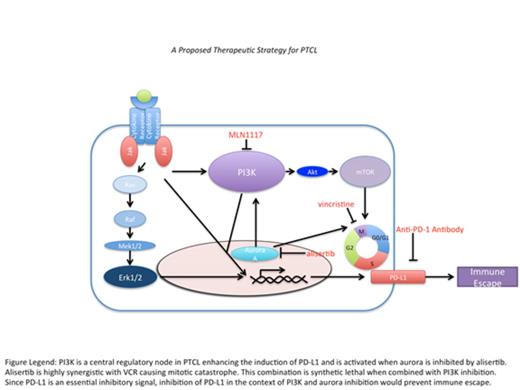Abstract
Introduction: Peripheral T-cell non-Hodgkin Lymphoma (PTCL) is heterogeneous and rare, accounting for 15% of non-Hodgkin lymphoma (NHL). PTCL is very aggressive, has a poor prognosis compared to B-NHL and novel therapeutic strategies are needed. Aurora A and B (AAK and ABK) are members of a highly conserved family of serine/threonine protein kinases that play key regulatory roles during normal and malignant mitosis. A recent study (SWOG1108, S1108) showed alisertib, a small molecular inhibitor of AAK/ABK to have a 30% response rate as a single-agent in relapsed/refractory PTCL (Barr et al. 2015, JCO). The novel mechanism of alisertib action provides a platform for synthetic lethal drug combinations. PI3Kinases are central signaling mediators which activate cell proliferation, immune regulation and lead to the activation of AAK/ABK through the mTOR pathway. MLN1117, a PI3KCa inhibitor is anti-proliferative and has anti-tumor activity in mouse models and in early phase clinical trials. The addition of MLN1117 to alisertib has the benefit of blocking the PI3K/mTOR and the MEK/ERK pathways. PD-L1 (CD274) is an immune checkpoint ligand that binds PD-1 and down-regulates the activity of active T-cells. PD-L1 expression is a mechanism of immune escape, allowing cancers to evade the immune system and represents a negative prognostic factor. Multiple receptor-mediated signaling pathways which regulate NF-κB, MAPK, PI3K/mTOR, and JAK/STAT are involved in PD-L1 induction. Using this mechanistic rationale, we investigated cellular drivers of PTCL in cell culture, a mouse xenograft model and in patient samples.
We hypothesized a novel therapeutic strategy where aurora inhibition provides a synthetic lethal platform to target PI3K and PD-L1 signaling in PTCL.
Methods: Immunohistochemistry (IHC) on 15 PTCL patient samples from S1108 was evaluated for Ki67, PD-1, and PD-L1 with reactive lymph node controls. Fluorescent microscopy provided quantification of PD-1, PD-L1 and Ki67. Cytokine arrays (RayBiotech) were used to evaluate cytokines that upregulate PD-L1 in S1108 samples. MTS assays were conducted with single agent alisertib, MLN1117, idelalisib and vincristine (VCR) in CRL-2396, TIB-48 and Jurkat T-NHL cell lines. Combination studies were conducted to ascertain IC50's and synergism (Chou-Talalay). A mouse CRL-2396 PTCL xenograft model was analyzed for anti-tumor activity of alisertib, alisertib + MLN1117, and alisertib + MLN1117 + VCR. The endpoints were response-to-therapy versus PD-1/PDL-1 expression by IHC and mechanisms of synergy-synthetic lethality.
Results: IHC of PTCL pre-alisertib (S1108) revealed PD-1 and PD-L1 expression were low while Ki-67 was high. PD-L1:PD-1 staining ratio was increased at 8.9 fold (p=0.0037). Cytokine profiling (pre-alisertib and post-alisertib day 8, n=12) indicated IFNg (n=2 inc, n=4 dec, n=6 NC); TNFa (n=4 inc, n=4 dec, n=4 NC); IL-2 (n=4 inc, n=3 dec, n=5 NC); GMCSF (n=3 inc, n=3 dec, n=6 NC). IC50's for alisertib 42.0 nM; MLN1117 22.16 mM, idelalisib (inactive) and VCR 1.09 nM. Combination indices (CI) indicated strong synergism for alisertib + MLN1117, alisertib + VCR and alisertib + MLN1117 + VCR. The mouse PTCL revealed significant decreases in mean tumor volume between alisertib alone versus control (mean decrease 497 mm3, p=0.042), alisertib + MLN1117 (mean decrease 1288 mm3 p<0.001) and alisertib + MLN1117 + VCR (mean decrease 2817.5 mm3, p<0.001). Mouse PTCL tumors are being evaluated PD-1/PD-L1 expression and PI3K signaling in PTCL.
Conclusion: PD-L1 is induced by chemokines and inactivates PI3K via SHP-2. However, PI3K activity induces PD-L1. Furthermore, alisertib activates PI3K/AKT hence targeting PI3K plus aurora (+VCR) abrogates PI3K activity and PD-L1 induction. Finally, PD-1/ PD-L1 IHC ratio may be useful in stratifying PTCL patients in prospective trials. The mechanistic interactions of aurora inhibition in the context of PI3K inhibition with PD-L1 blockade in under investigation (Figure 1).
No relevant conflicts of interest to declare.
Author notes
Asterisk with author names denotes non-ASH members.


This feature is available to Subscribers Only
Sign In or Create an Account Close Modal